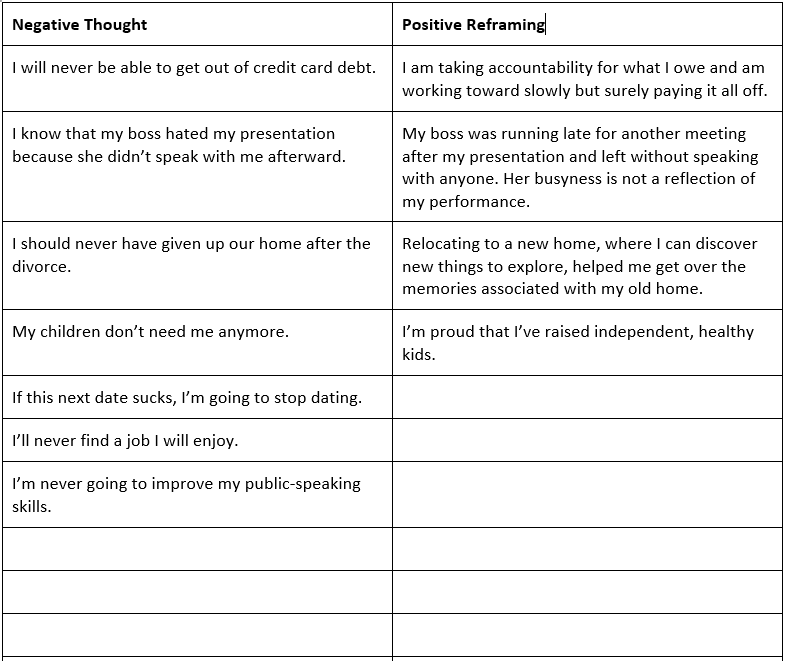Transform Your Mindset and Achieve More Joy with This One Powerful Reframing Tip

Are you the kind of person who fixates on one mistake or adverse comment after receiving an avalanche of praise? Ever find yourself consistently paying more attention to bad news over good? That’s true for many individuals and I’ve certainly been guilty of it in the past. However, when you consistently choose pessimism over optimism, there can be a steep price to pay.
Eternally focusing on the downside can prevent you from overcoming obstacles and thriving. Being a hard-core pessimist can also impact your relationship with yourself and others. If you always point out what could and probably will go wrong in every circumstance like a Debbie Downer, it sucks the joy out of everyone else’s life—including your own.
Determined to avoid disappointment, you can easily discount or avoid pursuing opportunities that may bring you joy. Predicting that the worst will happen makes sense in your mind, as it seems to protect you from an inevitable letdown. But—because you don’t reach for what you desire or take a chance to love, shine, trust, or grow—there’s nothing positive to be let down from.
Overcoming a Negativity Bias
Psychologists call exaggerated negative-thinking traps “cognitive distortions,” a concept popularized and defined in the 1980s by David Burns, who is now a clinical professor emeritus of psychiatry and behavioral sciences at Stanford University.
Some of them, such as “mental filtering” (sifting out all the positives to dwell on the negative) and “discounting the positive” (acknowledging but then dismissing the positive as worthless) are particularly insidious. Your brain tricks you into overestimating negative things and underestimating positive things—and you may or may not be aware of it. Kind of sucks, right?
Our tendency to gravitate toward the downside comes from a term psychologists call negativity bias. It means that most humans are hardwired to focus and respond to negative rather than positive stimuli, as it enables us to prepare for and avoid situations that may end badly.
Way back in the day, when we had to be aware of sabertooth tigers and other dangers, our fight-or-flight response played a key role in this tendency. Today, we usually don’t need that instinct to save us from a dangerous situation or negative outcome. But sometimes our brain doesn’t get the message—it’s still looking to protect us.
When a fight-or-flight sensation sets in, spurring an avalanche of negative impulses and emotions, it’s hard for some of us to think clearly. We may literally not be able to see a situation objectively or see how to get unstuck.
Experiencing frequent disappointments in your formative years can also create a pessimistic mindset. Bullying, the loss of a parent, poor living conditions, health challenges, and more can influence your perception, as you will tend to view the world around you as a punishing place. It can become natural to assume that the worst is yet to come.
You may also gravitate toward negative thinking because it gives you an illusion of control when things feel chaotic. If you loudly predict that everything that could go wrong will, and that comes to fruition, you get to say “I told you so” and be correct.
But it doesn’t have to be that way any longer. Here is an exercise to help you start reframing negative thoughts into more positive ones:
Step One: Set a baseline.
Start noticing how often you have negative thoughts, perhaps marking each instance down on a smart device or notepad. Tally up the number after a week, and you may be surprised by the frequency of this behavior. Consider what circumstances prompted each instance and identify patterns that are prompting the greatest amount of negative thinking.
Step Two: Determine what attitude you’d like to change.
Looking at the patterns that prompt the greatest amount of negativity, choose one thing to focus on at a time. For example, you might notice a recurring theme of negative thoughts around your relationship with money—how stupid you feel for racking up so much credit card debt, how you’re paying too much for your smartphone plan, how you can’t afford to renew your apartment lease, frustrations over not having savings for a rainy day, and more.
Step Three: When a negative thought arises, consider multiple perspectives to find a positive thought.
Remember, negative thinking is usually not accurate. If overwhelming positivity feels out of reach, choose, instead, to be neutral or realistic. Commonly, we turn to “all or nothing” thinking (words like always and never are usually used) when things are rarely so black and white.
Consider, too, how true this thinking is—is there any evidence to support it? You can also turn negative thoughts into opportunities. Rather than “having” to do something, you can “get” to do something. Instead of giving up when you encounter a roadblock, you can decide to overcome it.
Use the following chart to practice reframing your thoughts. I’ve filled out the first blocks to help you get started, and I’ve left the last few blank so you can add your own negative thoughts and the positive reframing for each.

Practice makes perfect! Run through this cognitive-reframing exercise on a regular basis to retrain your brain. From that place of possibility, you’re more apt to get unstuck and create effective solutions.
How have you reframed negative thinking into positive outcomes? How did those actions impact your career or personal life?
